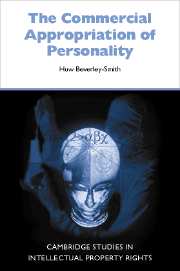Book contents
- Frontmatter
- Contents
- Preface
- Table of cases
- Table of statutes
- Part I A framework
- Part II Economic interests and the law of unfair competition
- 2 Introduction
- 3 Statutory and extra-legal remedies
- 4 Goodwill in personality: the tort of passing off in English and Australian law
- 5 Unfair competition and the doctrine of misappropriation
- Part III Dignitary interests
- Part IV Pervasive problems
- Part V Conclusions
- Bibliography
- Index
- Cambridge Studies in Intellectual Property
5 - Unfair competition and the doctrine of misappropriation
Published online by Cambridge University Press: 07 July 2009
- Frontmatter
- Contents
- Preface
- Table of cases
- Table of statutes
- Part I A framework
- Part II Economic interests and the law of unfair competition
- 2 Introduction
- 3 Statutory and extra-legal remedies
- 4 Goodwill in personality: the tort of passing off in English and Australian law
- 5 Unfair competition and the doctrine of misappropriation
- Part III Dignitary interests
- Part IV Pervasive problems
- Part V Conclusions
- Bibliography
- Index
- Cambridge Studies in Intellectual Property
Summary
Introduction
This chapter considers two separate notions which lie beyond the tort of passing off: a broad-based action for misappropriation of intangibles, and a much narrower sui generis tort of appropriation of personality. As regards the latter, the common law jurisdictions in Canada, most notably Ontario, have preferred not to follow the Australian example, and have recognised that the misappropriation of another person's name or likeness may, in certain circumstances, be an actionable wrong in itself. It should be noted that several parallel developments may be seen in the Canadian provinces: first, the statutory torts of invasion of privacy in Manitoba, British Columbia, Newfoundland and Saskatchewan; second, developments in Quebec, based on The Quebec Charter of Human Rights and Freedoms and the Civil Code; third, the Ontario common law tort of appropriation of personality; fourth, the embryonic common law tort of invasion of privacy. This chapter is only concerned with the common law tort of appropriation of personality which has been largely, although not exclusively, the work of the Ontario courts. Although the common law tort is still very much in its infancy, its development and scope are outlined below. Before doing so, the much wider, and more uncertain, notion of a tort of misappropriation of intangibles is considered briefly.
Misappropriation of intangibles
At various times it has been suggested that the Commonwealth courts have been going beyond the bounds of the tort of passing off and entering the realms of a new tort of unfair competition or misappropriation as the categories of actionable misrepresentation have been expanded and the requirement of damage accepted as being more readily satisfied.
- Type
- Chapter
- Information
- The Commercial Appropriation of Personality , pp. 111 - 138Publisher: Cambridge University PressPrint publication year: 2002



